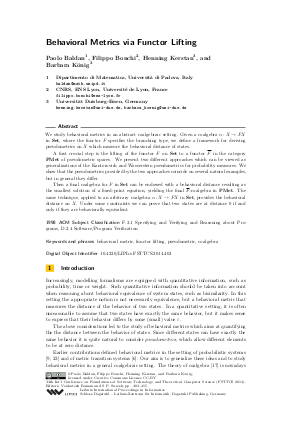Behavioral Metrics via Functor Lifting
Authors Paolo Baldan, Filippo Bonchi, Henning Kerstan, Barbara König
-
Part of:
Volume:
34th International Conference on Foundation of Software Technology and Theoretical Computer Science (FSTTCS 2014)
Part of: Series: Leibniz International Proceedings in Informatics (LIPIcs)
Part of: Conference: IARCS Annual Conference on Foundations of Software Technology and Theoretical Computer Science (FSTTCS) - License:
 Creative Commons Attribution 3.0 Unported license
Creative Commons Attribution 3.0 Unported license
- Publication Date: 2014-12-12
File

PDF
LIPIcs.FSTTCS.2014.403.pdf
- Filesize: 0.52 MB
- 13 pages
Document Identifiers
Subject Classification
Keywords
- behavioral metric
- functor lifting
- pseudometric
- coalgebra
Metrics
- Access Statistics
-
Total Accesses (updated on a weekly basis)
0Document
0Metadata
Abstract
We study behavioral metrics in an abstract coalgebraic setting. Given a coalgebra alpha : X -> FX in Set, where the functor F specifies the branching type, we define a framework for deriving pseudometrics on X which measure the behavioral distance of states. A first crucial step is the lifting of the functor F on Set to a functor /F in the category PMet of pseudometric spaces. We present two different approaches which can be viewed as generalizations of the Kantorovich and Wasserstein pseudometrics for probability measures. We show that the pseudometrics provided by the two approaches coincide on several natural examples, but in general they differ. Then a final coalgebra for F in Set can be endowed with a behavioral distance resulting as the smallest solution of a fixed-point equation, yielding the final /F-coalgebra in PMet. The same technique, applied to an arbitrary coalgebra alpha : X -> FX in Set, provides the behavioral distance on X. Under some constraints we can prove that two states are at distance 0 if and only if they are behaviorally equivalent.
Cite As Get BibTex
Paolo Baldan, Filippo Bonchi, Henning Kerstan, and Barbara König. Behavioral Metrics via Functor Lifting. In 34th International Conference on Foundation of Software Technology and Theoretical Computer Science (FSTTCS 2014). Leibniz International Proceedings in Informatics (LIPIcs), Volume 29, pp. 403-415, Schloss Dagstuhl – Leibniz-Zentrum für Informatik (2014)
https://doi.org/10.4230/LIPIcs.FSTTCS.2014.403
BibTex
@InProceedings{baldan_et_al:LIPIcs.FSTTCS.2014.403,
author = {Baldan, Paolo and Bonchi, Filippo and Kerstan, Henning and K\"{o}nig, Barbara},
title = {{Behavioral Metrics via Functor Lifting}},
booktitle = {34th International Conference on Foundation of Software Technology and Theoretical Computer Science (FSTTCS 2014)},
pages = {403--415},
series = {Leibniz International Proceedings in Informatics (LIPIcs)},
ISBN = {978-3-939897-77-4},
ISSN = {1868-8969},
year = {2014},
volume = {29},
editor = {Raman, Venkatesh and Suresh, S. P.},
publisher = {Schloss Dagstuhl -- Leibniz-Zentrum f{\"u}r Informatik},
address = {Dagstuhl, Germany},
URL = {https://drops.dagstuhl.de/entities/document/10.4230/LIPIcs.FSTTCS.2014.403},
URN = {urn:nbn:de:0030-drops-48599},
doi = {10.4230/LIPIcs.FSTTCS.2014.403},
annote = {Keywords: behavioral metric, functor lifting, pseudometric, coalgebra}
}
Author Details
References
-
Jiří Adámek. Free algebras and automata realizations in the language of categories. Commentationes Mathematicae Universitatis Carolinae, 015(4):589-602, 1974.

-
Giorgio Bacci, Giovanni Bacci, Kim G. Larsen, and Radu Mardare. On-the-fly exact computation of bisimilarity distances. In Proc. of TACAS'13, pages 1-15, 2013.

- Paolo Baldan, Filippo Bonchi, Henning Kerstan, and Barbara König. Behavioral metrics via functor lifting. Extended version with proofs, see http://arxiv.org/abs/1410.3385, 2014.
-
Filippo Bonchi, Daniela Petrisan, Damien Pous, and Jurriaan Rot. Coinduction up to in a fibrational setting. In Proc. of CSL-LICS'14, 2014.

-
Di Chen, Franck van Breugel, and James Worrell. On the complexity of computing probabilistic bisimilarity. In Proc. of FoSSaCS'12, volume 7213 of LNCS, pages 437-451, 2012.

-
Luca de Alfaro, Marco Faella, and Mariëlle Stoelinga. Linear and branching system metrics. IEEE Transactions on Software Engineering, 25(2), 2009.

-
Yuxin Deng, Tom Chothia, Catuscia Palamidessi, and Jun Pang. Metrics for action-labelled quantitative transition systems. ENTCS, 153(2):79-96, 2006.

-
Josée Desharnais, Abbas Edalat, and Prakash Panangaden. Bisimulation for labelled Markov processes. Information and Computation, 179(2):163-193, 2002.

-
Josée Desharnais, Vineet Gupta, Radha Jagadeesan, and Prakash Panangaden. Metrics for labelled Markov processes. TCS, 318(3):323-354, 2004.

-
Joseé Desharnais, Radha Jagadeesan, Vineet Gupta, and Prakash Panangaden. The metric analogue of weak bisimulation for probabilistic processes. In Proc. of LICS'02, pages 413-422. IEEE, 2002.

-
Daniel Gebler and Simone Tini. Compositionality of approximate bisimulation for probabilistic systems. In Proc. of EXPRESS/SOS'13, pages 32-46, 2013.

-
Alessandro Giacalone, Chi-Chang Jou, and Scott A. Smolka. Algebraic reasoning for probabilistic concurrent systems. In Proc. IFIP TC2 Working Conference on Programming Concepts and Methods, pages 443-458. North-Holland, 1990.

-
Ichiro Hasuo, Kenta Cho, Toshiki Kataoka, and Bart Jacobs. Coinductive predicates and final sequences in a fibration. ENTCS, 298:197-214, 2013.

-
Ichiro Hasuo, Bart Jacobs, and Ana Sokolova. Generic trace semantics via coinduction. LMCS, 3 (4:11):1-36, November 2007.

-
Bartek Klin. Bialgebras for structural operational semantics: An introduction. TCS, 412(38):5043-5069, 2011.

-
Kim G. Larsen and Arne Skou. Bisimulation through probabilistic testing. In Proc. of POPL'89, pages 344-352, 1989.

-
J. J. M. M. Rutten. Universal coalgebra: a theory of systems. TCS, 249:3-80, 2000.

-
Lutz Schröder. Expressivity of coalgebraic modal logic: The limits and beyond. TCS, 390(2-3):230-247, 2008.

-
Ana Sokolova. Probabilistic systems coalgebraically: A survey. TCS, 412(38):5095-5110, 2011. CMCS Tenth Anniversary Meeting.

-
Franck van Breugel, Claudio Hermida, Michael Makkai, and James Worrell. Recursively defined metric spaces without contraction. TCS, 380(1-2):143-163, July 2007.

-
Franck van Breugel, Babita Sharma, and James Worrell. Approximating a behavioural pseudometric without discount for probabilistic systems. LMCS, 4(2), 2008.

-
Franck van Breugel and James Worrell. A behavioural pseudometric for probabilistic transition systems. TCS, 331:115-142, 2005.

-
Franck van Breugel and James Worrell. Approximating and computing behavioural distances in probabilistic transition systems. TCS, 360(1):373-385, 2006.

-
Cédric Villani. Optimal Transport - Old and New, volume 338 of A Series of Comprehensive Studies in Mathematics. Springer, 2009.

